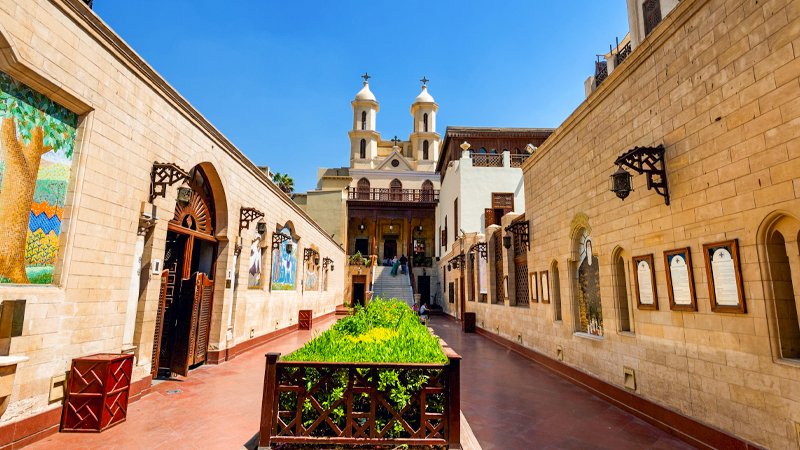The Hanging Church, also known as Saint Virgin Mary’s Coptic Orthodox Church, is one of the oldest and most historically significant churches in Egypt. Situated in the heart of Old Cairo, this architectural marvel is suspended above a gatehouse of the ancient Roman fortress, Babylon. Its name “Hanging” or “Suspended” Church comes from its unique location, elevated on the ruins, giving the impression that it is floating. Dating back to the 3rd century AD, the Hanging Church has witnessed the passage of centuries, reflecting the rich tapestry of Egypt’s religious and cultural history. As a crucial site for both Coptic Christians and tourists, it encapsulates the essence of Egypt’s enduring spiritual legacy.
Historical Significance of the Hanging Church
The Hanging Church stands as a testament to Egypt’s deep-rooted Christian heritage. Built on the site where the Holy Family is believed to have rested during their flight into Egypt, it holds immense spiritual significance. Over the centuries, the church has played a pivotal role in the religious and political landscape of the region. It served as the residence of the Coptic Patriarchs until the 14th century and was a central hub for important ecclesiastical decisions. The church has undergone several restorations, especially during the Islamic era, indicating the coexistence and mutual respect between different religious communities in Egypt. Its rich history is etched in its architecture, manuscripts, and relics, making it a vital link to the past.
Architectural Marvels of the Hanging Church
The architectural design of the Hanging Church is a remarkable blend of different styles, reflecting the diverse influences that have shaped it over centuries. The church’s most distinctive feature is its wooden roof, designed to resemble Noah’s Ark, symbolizing salvation. Inside, the church is adorned with beautiful icons, some dating back to the 8th century, depicting saints, biblical scenes, and the Virgin Mary. The intricate wooden screens (iconostasis) and the marble pulpit with its thirteen pillars, representing Jesus and his disciples, are other highlights. The nave is flanked by two aisles, separated by rows of ancient columns, each unique in material and design, adding to the church’s aesthetic and historical value.
Religious Significance and Pilgrimages
For Coptic Christians, the Hanging Church is not just a historical monument but a living place of worship and pilgrimage. It hosts regular services and religious ceremonies, attracting believers from around the world. The church is especially significant during the Feast of the Assumption of Mary, drawing large crowds for the celebrations. Pilgrims come to seek blessings, pray, and immerse themselves in the spiritual ambiance that has been preserved for over a millennium. The church’s connection to the Holy Family’s journey through Egypt enhances its religious importance, making it a focal point of Coptic Christian faith and heritage.
The Hanging Church and the Coptic Museum
Adjacent to the Hanging Church is the Coptic Museum, which houses an extensive collection of artifacts that shed light on the history and culture of Coptic Christians in Egypt. The museum’s exhibits include ancient manuscripts, textiles, icons, and other religious artifacts that provide context to the history and significance of the Hanging Church. Visiting the museum complements the experience of the church, offering deeper insights into the Coptic heritage and the role of Christianity in Egypt. The proximity of the church and the museum makes it an essential stop for anyone interested in exploring Egypt’s religious history.
Restoration and Preservation Efforts
Preserving the Hanging Church’s structural integrity and historical authenticity has been a priority over the years. Various restoration projects have been undertaken to repair damage caused by natural elements and human activities. Efforts have focused on reinforcing the foundations, restoring the wooden roof, and conserving the ancient icons and relics. International organizations, alongside the Egyptian government and the Coptic Church, have collaborated on these preservation initiatives. These efforts ensure that the Hanging Church remains a living monument, accessible to future generations of worshippers and tourists alike.
Cultural Impact and Modern Relevance
The Hanging Church is not just a relic of the past but continues to play a vital role in the cultural and religious life of Cairo. It stands as a symbol of the enduring presence of Christianity in Egypt and the resilience of the Coptic community. The church also serves as a cultural bridge, attracting visitors from diverse backgrounds who come to appreciate its historical and architectural significance. In modern times, the Hanging Church has been a site for interfaith dialogue, promoting understanding and coexistence in a region with a rich tapestry of religious traditions. Its relevance extends beyond its walls, contributing to the broader cultural and spiritual landscape of Egypt.
The Hanging Church in Egyptian Tourism
As one of the key attractions in Cairo, the Hanging Church is a highlight for tourists exploring Egypt’s rich historical and cultural sites. It is often included in tours that cover Old Cairo, alongside other significant landmarks such as the Ben Ezra Synagogue, the Amr Ibn Al-As Mosque, and the Coptic Museum. The church offers visitors a unique glimpse into the ancient Christian heritage of Egypt, contrasting with the more widely known Pharaonic monuments. For travel agencies and tour operators, the Hanging Church is a must-visit destination that enriches the overall experience of exploring Egypt’s diverse historical landscape.
Visiting the Hanging Church: Practical Information
For travelers planning to visit the Hanging Church, it is important to note the practical aspects to ensure a smooth and enriching experience. The church is located in the Coptic Quarter of Old Cairo, easily accessible by metro or taxi. It is open to visitors daily, with specific hours for tours and services. Modest dress is required, respecting the sanctity of the religious site. Photography is usually allowed, but it is advisable to check for any restrictions, especially during services. Nearby amenities, including cafes and souvenir shops, enhance the visit, allowing tourists to enjoy a comprehensive cultural experience in the heart of Cairo.
The Hanging Church: A Personal Experience
Visiting the Hanging Church is more than just a touristic activity; it is a journey through time and spirituality. The serene ambiance, coupled with the historical richness of the site, provides a deeply moving experience. For many visitors, walking through the church’s halls, admiring the ancient icons, and participating in a service can be a profound moment of connection to the past. The sense of history is palpable, making the visit not only educational but also emotionally fulfilling. Sharing personal experiences and reflections from previous visitors can inspire and guide new travelers in their exploration of this historical gem.
The Hanging Church in Literature and Art
The Hanging Church has inspired countless artists, writers, and historians over the centuries. Its unique architectural beauty and historical significance have been captured in various forms of art, including paintings, literature, and documentaries. Writers have chronicled its history and the stories of those who have worshipped within its walls, while artists have depicted its serene beauty and intricate details. These cultural representations help to preserve and propagate the legacy of the Hanging Church, ensuring that its story reaches a global audience. The church’s influence on art and literature underscores its importance as a cultural and historical treasure.
The Role of the Hanging Church in Interfaith Relations
The Hanging Church has played a significant role in fostering interfaith relations in Egypt. Its history is marked by periods of cooperation and mutual respect between different religious communities. In contemporary times, the church continues to be a venue for interfaith dialogue and understanding. By hosting events and discussions that bring together people of different faiths, the Hanging Church contributes to a more inclusive and harmonious society. Highlighting these efforts in the article can attract a broader audience, showcasing Egypt as a land of diverse religious heritage and coexistence.
Future Prospects and Challenges
Looking ahead, the Hanging Church faces both opportunities and challenges. As a prominent historical and religious site, it has the potential to attract even more visitors and researchers interested in Egypt’s Christian heritage. However, ongoing preservation efforts are crucial to protect the church from the effects of time and environmental factors. Balancing the influx of tourists with the need to maintain the church’s sanctity and structural integrity is a key challenge. Future plans may include enhanced visitor facilities, more comprehensive restoration projects, and increased collaboration with international heritage organizations to ensure the Hanging Church remains a cherished landmark for generations to come.
Conclusion: The Timeless Legacy of the Hanging Church
In conclusion, the Hanging Church in Cairo stands as a remarkable testament to Egypt’s rich and diverse history. Its unique architectural features, profound religious significance, and enduring cultural impact make it a must-visit destination for travelers exploring Egypt. By highlighting the church’s historical journey, architectural marvels, and role in modern society, this article aims to provide a comprehensive and engaging overview for potential visitors. The Hanging Church is more than just a historical site; it is a living symbol of Egypt’s enduring spiritual and cultural heritage, inviting all who visit to connect with its timeless legacy.

